Can Jasmine Grow Indoors?
Yes, Jasmine can be grown indoors. However, it is best to know how to grow it inside your house, their growing requirements, what varieties, and common problems in growing this fragrant flowering plant. No matter what USDA zone you live in, you can enjoy the delicate, fragrant blooms of Jasmine by growing it indoors. It’s also a pleasantly simple and fun process.
Indoor Jasmine allows you to enjoy the plant’s attractive foliage and decorative blooms during the dreary winter months. Additionally, the plant’s distinctively sweet scent will fill your home from dawn to dusk.
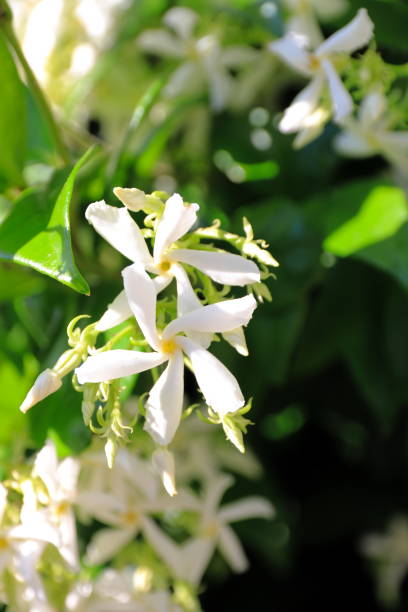
Table of Contents
Growing Requirements
Sunlight
Select a room that is well-lit or receives a lot of sunlight and one that has a lot of air movement. There are only about four hours of direct sunlight per day that jasmine plants can withstand, and they need even less during the winter months. If your plant is getting too much sun, you may want to reduce the amount of light it receives by closing your blinds or moving it.
When your plant is placed in a southern-facing window, it will get more sunlight, which is especially beneficial during the plant’s most critical growth periods. Move your plants to a shadier spot immediately if the leaves have begun to wilt.
Keep your Jasmine plant’s leaves clean by wiping them down every few months. The accumulation of dust on the leaves of indoor plants can harm their ability to absorb sunlight and thrive.
Water
When it comes to their water requirements, jasmine plants require very little attention from the gardener. They require little water after their blooms have faded (which usually occurs in the early winter and early spring). Still, they benefit from a moist growing environment, especially in warmer climates, throughout the rest of the year. Although you don’t want the soil to be sopping wet, it should always be slightly damp to the touch.
Once or twice a week, give your jasmine plant some water. When you water, make sure to water deeply so that moisture has a chance to reach the plant’s roots and grow. If you want to learn how to water indoor plants without making a mess, I have a fantastic guide that you should definitely check out.
Watering your plant every day, but only for a few seconds at a time, is not a good idea. Many gardeners believe that this is the “right” way to water their plants, but this is not the case. If this practice is followed, water will not reach the plant’s thirsty roots. You will keep your plant perfectly hydrated if you reduce the frequency of your watering patterns while increasing the intensity of your watering patterns.
Because of the frequency with which they require watering, you might want to consider using a self-watering planter to keep your Jasmine plant in a moist environment. Learn more about how self-watering planters work and see some of my favorite self-watering planters right here!
A watering globe or watering spike, on the other hand, will perform a similar function. It’s a good option for watering your Jasmine plant while on vacation or regularly. Here are some additional options for watering your houseplants if you’re going on vacation.
Soil
When you buy jasmine plants, you will almost always get them on rings, even if you buy them from a store or a nursery. Jasmine is usually put in the ground in late spring, and rooted cuttings grow quickly (up to six inches a day!). To grow strong, branching plants, these cuttings are cut back. Then, the stems of the plants are gradually trained to grow along with a wire form. Many people see flower buds for the first time in early to late fall. At this point, they are ready to be shipped.
This means that when you get your jasmine plant going in the right way, it will likely bloom and grow a lot.
Jasmine plants like soil that is porous and easy to drain. You can add bark, coir, or other organic matter to the soil. This will help the soil drain and keep it light and airy. Use sphagnum or peat moss to grow your Jasmine, or you can buy a potting mix from the store to do it for you. A good potting mix should be made up of vermiculite, perlite, and peat moss. These mixtures will be able to absorb water and resist being compacted.
Fertilizer
There are numerous methods for fertilizing Jasmine. During the entire growing season, you can use a diluted houseplant food or add a high-phosphorus fertilizer to prolong the blooming period of your Jasmine.
Jasmine should be fertilized every two to four weeks during the spring and early fall months. Don’t fertilize your plants during the winter months, as this can harm them.
Use a water-soluble fertilizer when you’re doing your gardening. When fertilizing houseplants, use only half the recommended fertilizer rate that is specifically formulated for that purpose. There’s a chance that fertilizer applied at full strength will harm your Jasmine.
As long as you use organic fertilizer, you won’t have to worry about harming your plant by using an excessively strong fertilizer, which can harm your plant.
Add aged compost, leaf mold, or composted peat as an organic matter source. It is ideal if the soil in your container contains at least twenty percent organic matter. As a result, your soil will be more hospitable to beneficial microorganisms and micronutrients.
Be aware that synthetic fertilizers contain only trace amounts of micronutrients like sodium, calcium, and magnesium, essential for plant growth. Your jasmine plant relies on these micronutrients, but synthetic fertilizers typically only contain nitrogen, phosphorous, and potassium.
The micronutrients found in soil, but missing from commercial fertilizers and potting mix, may be necessary if you’re trying to grow Jasmine indoors.
Keep the mixed light and airy so that oxygen, water, and nutrients can flow freely through it when you repot. Because you’re growing your Jasmine indoors, you won’t be able to take advantage of soil-tilling processes like earthworms and weather.
Repotting
In contrast to many other houseplants, the Jasmine can wait for quite a while before it needs to be replanted. Repotting it before it has completely outgrown its container is essential because it does best when it is a little cramped.
Repotting Jasmine is straightforward after that. Ideally, you should only re-pot it after the roots have completely grown into the pot in the spring. Your Jasmine plant should be moved to a new pot every few years, so this is a good time to choose a planter that complements your home or decor.
It’s time to repot your plant when the roots begin to outgrow the soil. Take care not to damage the plant’s delicate roots when moving it and make any necessary prunings before relocating it to new soil. You can begin by laying out the plant on a piece of old paper. Take the root ball out of the pot and loosen it with your hands. Remove the root ball.
Make four or five vertical slices in the sides of the root ball to remove any long strands of roots. Replant the slices in a new pot that is approximately two inches larger in diameter than the previous pot, encouraging new root growth.
Best Indoor Jasmine Varieties
Arabian Jasmine
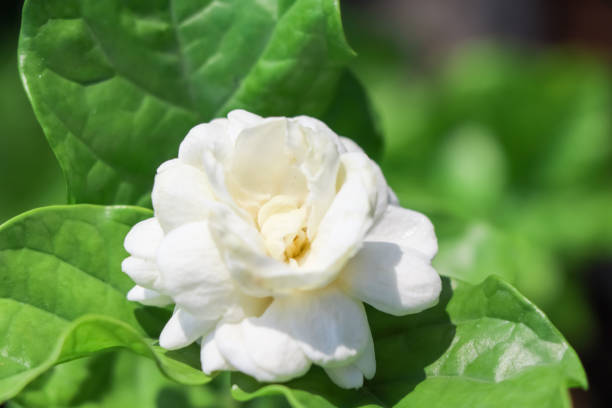
It’s a species of Jasmine native to southwestern Arabia and northeastern Africa. It has a long, slender, aromatic stem and narrow leaves. The blooms are tiny white or yellow. It is a 2 meter tall deciduous shrub.
Common Jasmine
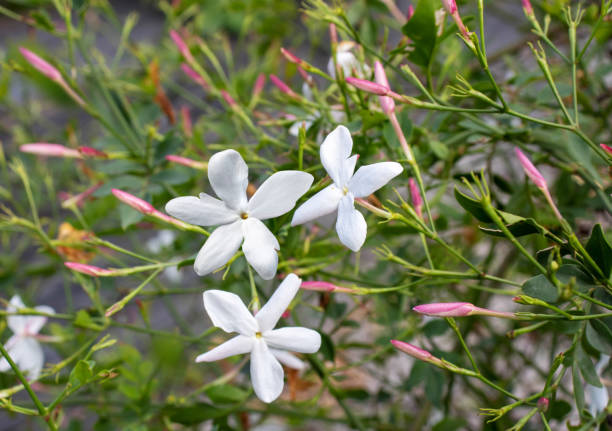
Most people have this type of Jasmine in their homes because it can grow there easily. Can grow to ten feet tall. It blossoms from June to October, but it doesn’t bloom all the time.
Italian Jasmine
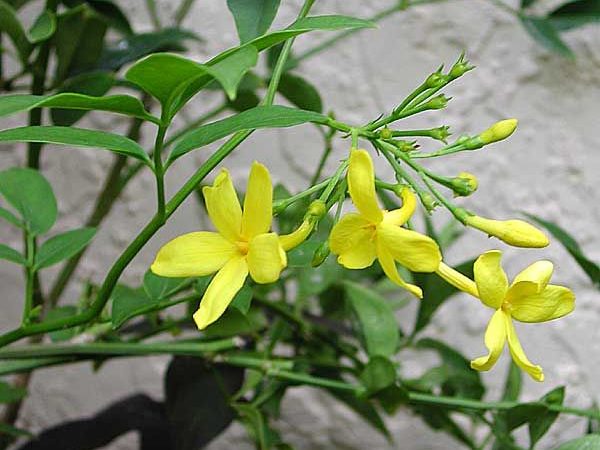
It’s an evergreen shrub that grows to a height of around three meters. The leaves are oval-shaped and have serrated edges. The blooms are white and have a sweet, floral fragrance.
Madagascar Jasmine
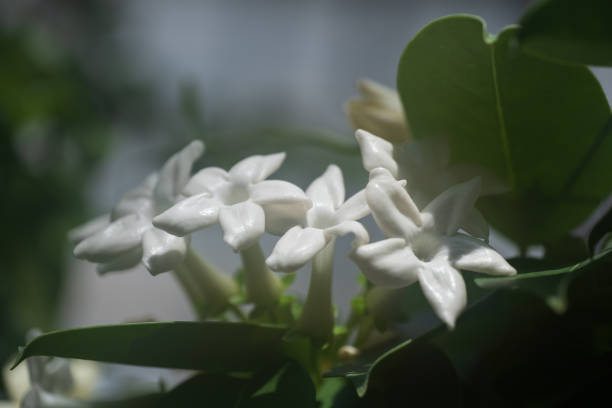
Madagascar Jasmine is a climbing vine that can grow as tall as 25 feet. The leaves are heart-shaped and have a unique fragrance. The flowers are white with a purple center, and they produce nectar that pollinates other plants.
Primrose Jasmine
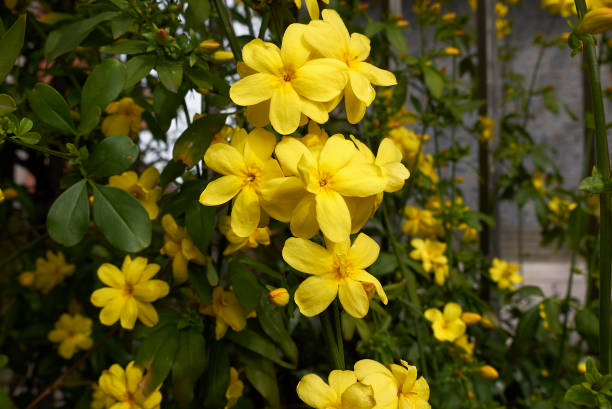
As these jasmine varieties don’t reach heights of more than ten feet, they’re suitable for indoor cultivation. The flowers, which are trumpet-shaped and fragrant, are native to the Mediterranean region.
Showy Jasmine
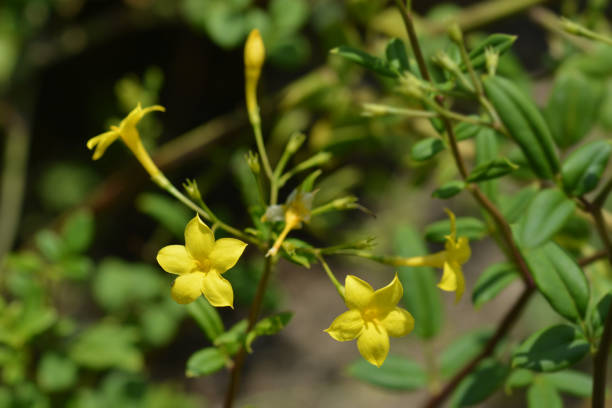
This is showy Jasmine that is highly fragrant. It grows two feet tall. It has large, bell-shaped flowers stained a deep yellow with purple veins. It blooms in spring and into the summer, but it is reliable.
Spanish Jasmine
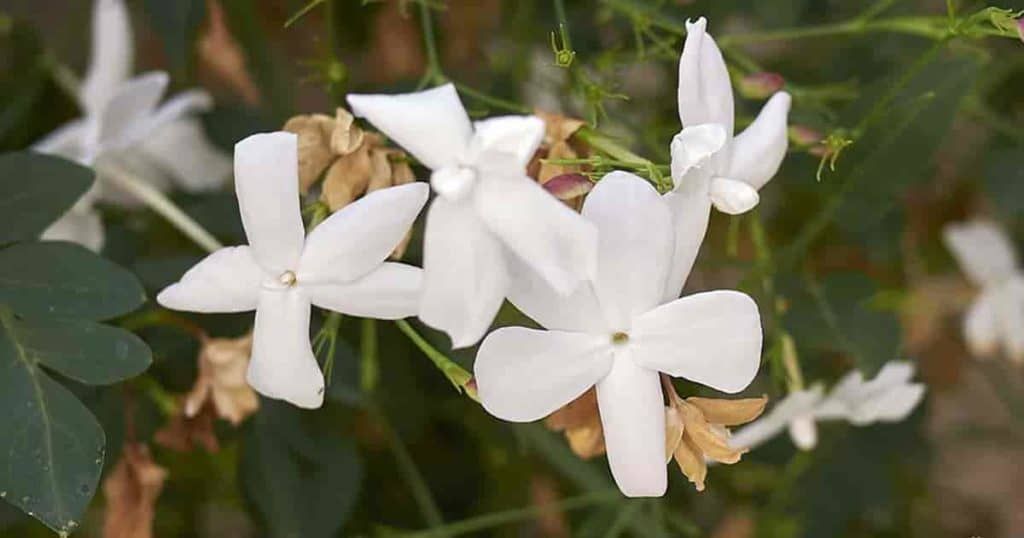
A semi-deciduous plant is easy to care for because it sheds when new growth comes in. Aromatherapy will become a part of your daily routine if you have this in your home.
Star Jasmine
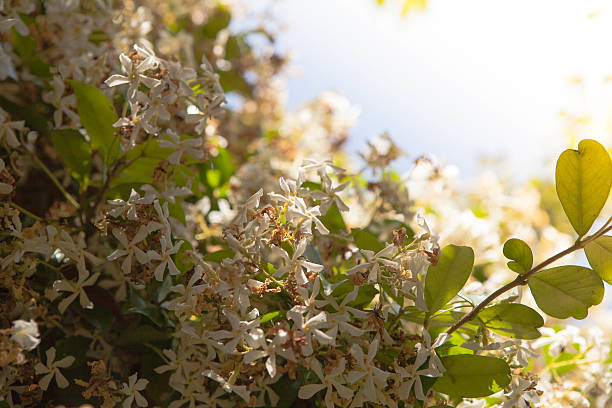
Star Jasmine’s star-shaped white flowers with a sweet scent will draw your attention. Pruning regularly is the best strategy for controlling its rapid and excessive growth.
Winter Jasmine
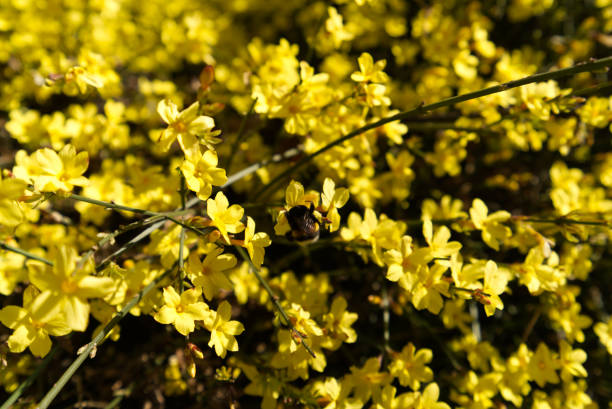
It’s a common sight in the gardens of Victorian homes. The 1-inch wide, unscented yellow flowers appear in the winter or early spring before the leaves emerge. Using winter jasmine to cover a bank is a good idea because it will root where its stems contact the soil. The branches dangling over retaining walls make for a stunning focal point. Vines such as this one attract hummingbirds because of their vigorous growth.
White Jasmine
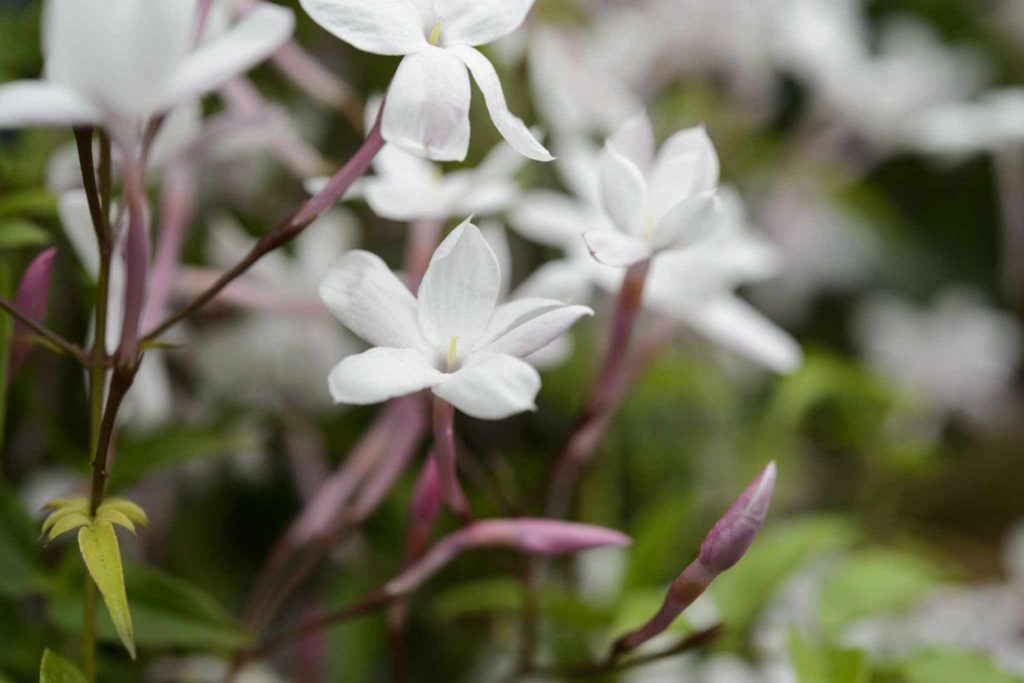
Indoor growers prefer to use this type of Jasmine. Jasmine, also known as winter or pink Jasmine, is a popular variety that thrives in USDA zones 6 to 10 and can be grown in the winter. It can withstand a light frost and reach a height of 15 feet when grown as a vine or shrub.
Common Problems with Indoor Jasmines
Overwatering and a Lack of Light
This is what happens when there is a lot of soil and mold on the soil. Replace the top two inches of soil with a fresh batch of “Houseplant” compost. Increase the amount of light they get (no direct sunlight for the first few weeks to avoid a shock) or cut back on how often they drink water. Mould can make the leaves on the bottom of your plants turn yellow, which could be a sign of root rot.
Underwatering
Typical symptoms include wilting, sunken leaves, rapid flower or bud drop, and stunted growth. Additionally, you’ll need to consider which parts of the plant should be kept dry in the event of prolonged droughts. To avoid the spread of disease and blight, the foliage must also be kept completely dry at all times. Under-watering is more likely to occur in jasmine plants in direct sunlight or within four meters of a radiator.
Too Much Sunlight Causes Sunburn
Dry leaf-edges, crispy leaves, sunken leaves, or stunted growth are all typical symptoms. Reduce the amount of sunlight in your home if it doesn’t meet these standards, and be on the lookout for signs of environmental shock (when locations offer too different growing conditions). In addition to removing some of the weakened leaves, you should also slightly raise the water level. Only use the bottom-up method to hydrate the plant.
Powdery Mildew and Botrytis Are Major Threats
Diseases spread more easily among plants with dense foliage because of the plants’ compact nature. Overwatering will allow harmful bacteria to flourish in the stem’s cubbyholes, so make sure to water below the foliage. Rejuvenate the plant’s growing conditions by moving it to a more sunny spot and watering it from the bottom up.
No Direct Sunlight or Heat Sources Within Four Metres of an Indoor Jasmine
As an example, consider a radiator or a fireplace. Because of the increased temperature, the plant will absorb significantly more moisture than plants in cooler climates, increasing the likelihood of droughts.
A Variety of Factors Can Contribute to Sudden Flower Loss
Location changes, too little water, hot or cold temperatures, droughts, and pests can all cause plants to not grow well. During bloom, keep the soil evenly moist. This will help the plant’s thirsty work of making flowers. Jasmines can be very sensitive to the temperature in which they live, so places outside of the recommended temperature range or have many big temperature changes should also be off the table. The last thing could be about pests. Check for Vine Weevils, Spider Mites, Aphids, and Mealybugs. Even though it’s very unlikely that an infestation will cause a sudden change in your health, do a quick check.
Insufficient Dormancy Period Causes Lack of Flowers
During the winter, this dish is served. All year, locations with near-constant temperatures will not allow the plant to go dormant, resulting in poor spring growth. To accomplish this, choose a location where the temperature drops to around 12°C (54°F), and there are fewer bodies of water. While the radiators are on, allow the majority of the compost to dry out and provide a humidity tray.
Pest and Diseases
The common Jasmine has few pests or diseases to contend with. Spider mites can attack winter jasmine. If this occurs, remove the infested plant material and dispose of it by cutting it to the ground after it blooms. To encourage new growth, feed the crowns. Fertilizer is needed if the leaves are yellow, and this should be done in the spring. Look out for mealybugs on your houseplants (white, cottony masses under leaves and on stems). Use an alcohol-soaked cotton swab to get rid of it.
